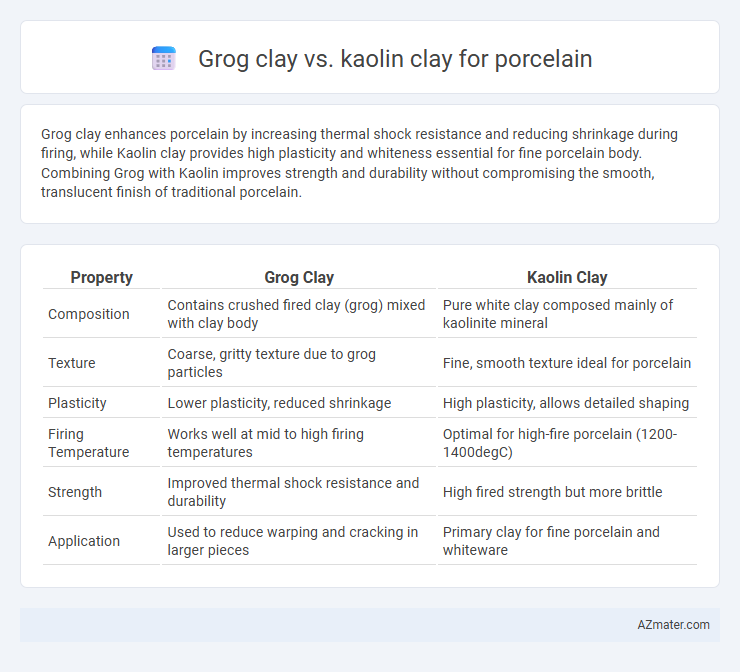Grog clay enhances porcelain by increasing thermal shock resistance and reducing shrinkage during firing, while Kaolin clay provides high plasticity and whiteness essential for fine porcelain body. Combining Grog with Kaolin improves strength and durability without compromising the smooth, translucent finish of traditional porcelain.
Table of Comparison
| Property | Grog Clay | Kaolin Clay |
|---|---|---|
| Composition | Contains crushed fired clay (grog) mixed with clay body | Pure white clay composed mainly of kaolinite mineral |
| Texture | Coarse, gritty texture due to grog particles | Fine, smooth texture ideal for porcelain |
| Plasticity | Lower plasticity, reduced shrinkage | High plasticity, allows detailed shaping |
| Firing Temperature | Works well at mid to high firing temperatures | Optimal for high-fire porcelain (1200-1400degC) |
| Strength | Improved thermal shock resistance and durability | High fired strength but more brittle |
| Application | Used to reduce warping and cracking in larger pieces | Primary clay for fine porcelain and whiteware |
Introduction to Porcelain Clays
Grog clay and kaolin clay are essential materials in porcelain production, each contributing distinct properties to the final product. Kaolin clay, a primary component, is highly refined and known for its purity, whiteness, and high refractory quality, which ensures strength and translucency in porcelain. Grog clay, composed of pre-fired clay particles, enhances thermal shock resistance and structural integrity by reducing shrinkage and warping during firing, complementing kaolin's fine texture.
What is Grog Clay?
Grog clay is a type of ceramic clay mixed with ground fired clay particles, known as grog, which improves the thermal shock resistance and reduces shrinkage during firing. In porcelain production, grog clay enhances durability by adding grit and texture that helps prevent cracking and warping. Unlike pure kaolin clay, which is prized for its whiteness and plasticity, grog clay is favored for structural strength and stability in high-temperature applications.
What is Kaolin Clay?
Kaolin clay, also known as china clay, is a primary ingredient in porcelain manufacturing due to its fine particle size, high alumina content, and excellent plasticity, which contribute to the porcelain's whiteness, translucency, and strength. Unlike grog clay, which contains pre-fired, crushed particles to reduce shrinkage and enhance texture, kaolin clay provides the essential purity and whiteness that defines high-quality porcelain ceramics. Its refractory properties and minimal impurities make kaolin clay indispensable for producing delicate yet durable porcelain wares.
Key Properties of Grog Clay
Grog clay for porcelain contains pre-fired clay particles that enhance thermal shock resistance and reduce shrinkage during firing, providing improved strength and dimensional stability compared to pure kaolin clay. The inclusion of grog increases porosity, which aids in moisture regulation and facilitates drying without cracking, making it ideal for complex and large porcelain pieces. While kaolin clay offers high whiteness and plasticity essential for fine porcelain, grog clay's refractory properties ensure better durability and structural integrity in the finished product.
Key Properties of Kaolin Clay
Kaolin clay, prized for its high purity and fine particle size, exhibits excellent plasticity and whiteness, making it ideal for porcelain production. Its low iron content ensures minimal discoloration during firing, contributing to the bright, translucent quality characteristic of fine porcelain. Compared to grog clay, kaolin's superior refractory properties allow it to withstand high temperatures without warping, enhancing the strength and durability of the finished porcelain.
Workability: Grog Clay vs Kaolin Clay
Grog clay enhances workability in porcelain by adding coarse, pre-fired clay particles that reduce shrinkage and improve structural strength during drying and firing. Kaolin clay, known for its fine particle size and purity, offers a smooth, plastic texture ideal for detailed shaping but can shrink and crack more easily without grog. Balancing grog and kaolin optimizes porcelain's workability by combining plasticity with dimensional stability.
Firing Performance and Shrinkage
Grog clay enhances porcelain's firing performance by increasing thermal shock resistance and reducing warping during firing, thanks to its pre-fired, coarse particle structure that aids in controlled shrinkage. Kaolin clay, known for its purity and fine particle size, offers excellent plasticity and whiteness but tends to shrink more during firing, requiring precise control to avoid cracking. Combining grog with kaolin in porcelain bodies balances shrinkage rates and improves dimensional stability while maintaining the desired translucency and strength.
Surface Finish and Aesthetics
Grog clay enhances porcelain's surface finish by adding texture and reducing shrinkage, resulting in a more rustic and matte aesthetic ideal for sculptural pieces. Kaolin clay offers a smooth, highly refined surface with excellent whiteness and translucency, producing a classic, polished, and elegant porcelain appearance. Choosing between grog and kaolin clays depends on whether a textured, earthy finish or a delicate, luminous aesthetic is prioritized in the final porcelain product.
Best Uses in Porcelain Art and Ceramics
Grog clay enhances porcelain's thermal shock resistance and reduces shrinkage, making it ideal for large-scale or sculptural porcelain pieces prone to cracking. Kaolin clay, prized for its purity and fine particle size, produces a smooth, white, and translucent finish, perfect for delicate porcelain tableware and fine art ceramics. Artists seeking durability combined with refined surface quality often blend grog with kaolin to balance strength and aesthetic appeal in porcelain creations.
Choosing the Right Clay for Your Project
Grog clay enhances porcelain's durability and reduces shrinkage, making it ideal for projects requiring structural strength and thermal shock resistance. Kaolin clay produces a smooth, white, and translucent finish, perfect for fine, delicate porcelain with high aesthetic appeal. Selecting between grog and kaolin depends on whether the priority is mechanical stability or refined surface quality in your porcelain creation.

Infographic: Grog clay vs Kaolin clay for Porcelain
 azmater.com
azmater.com